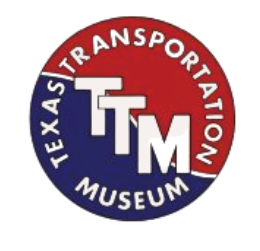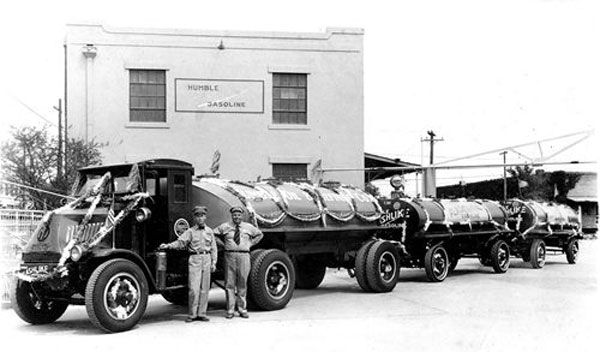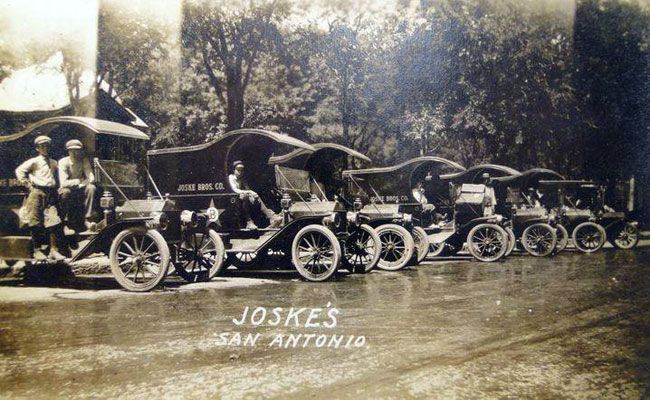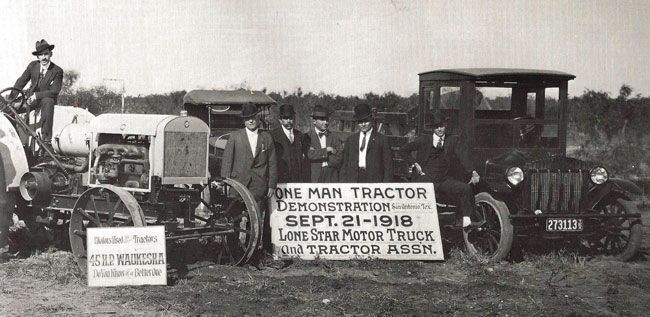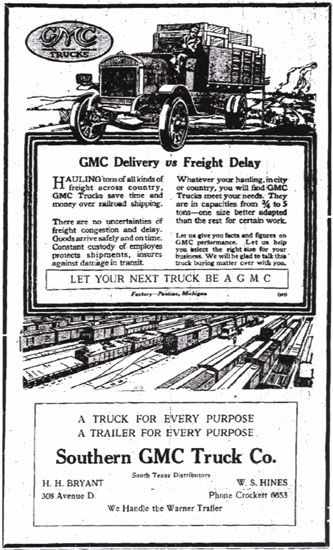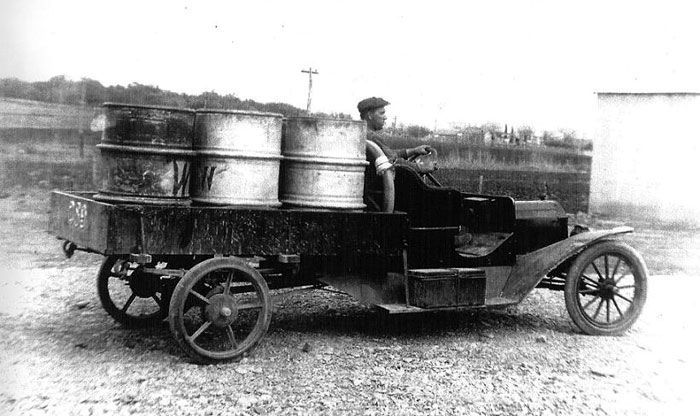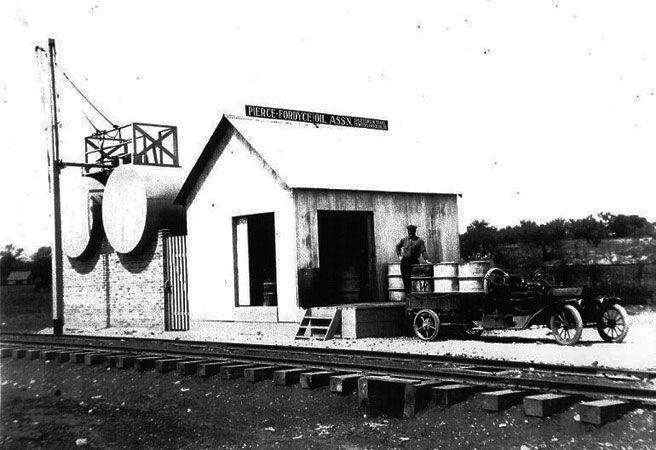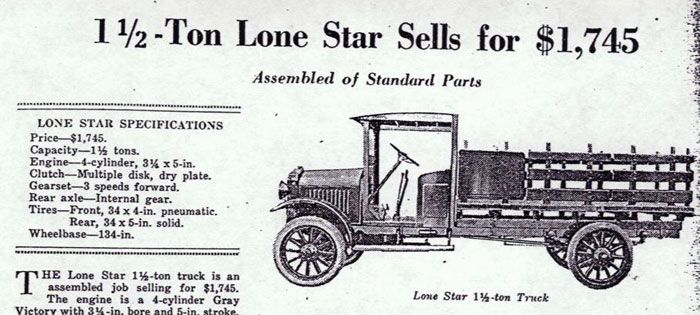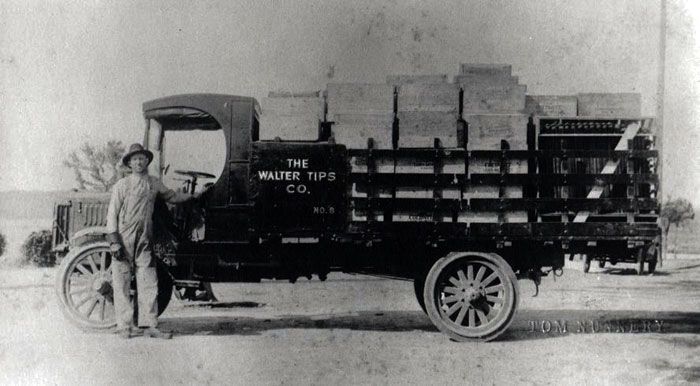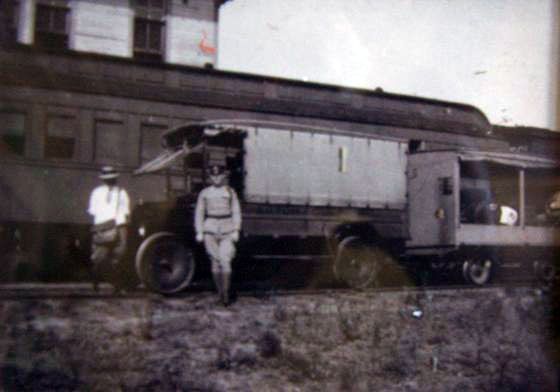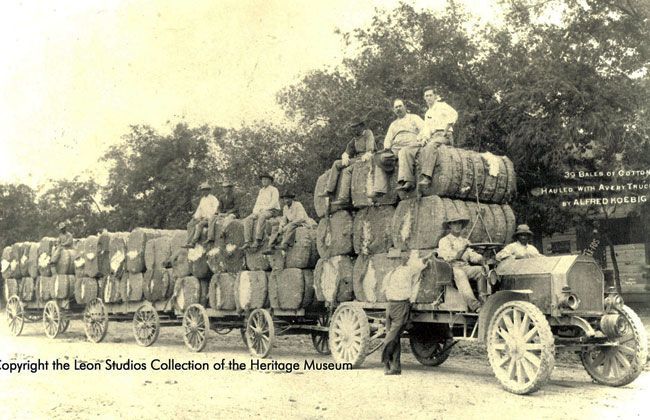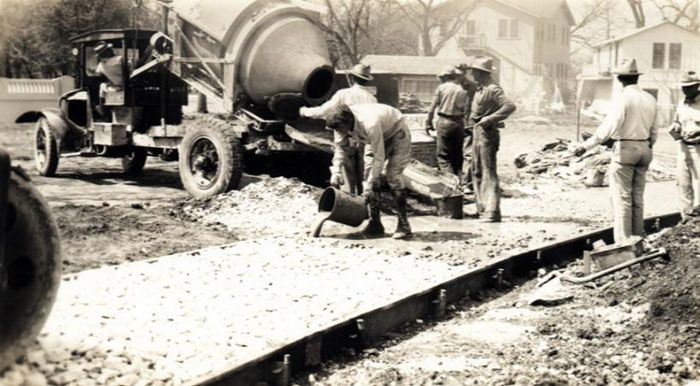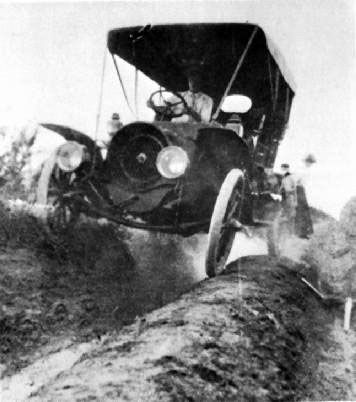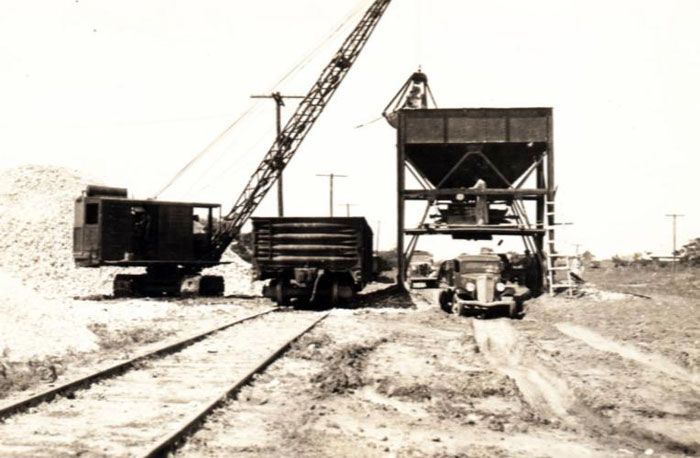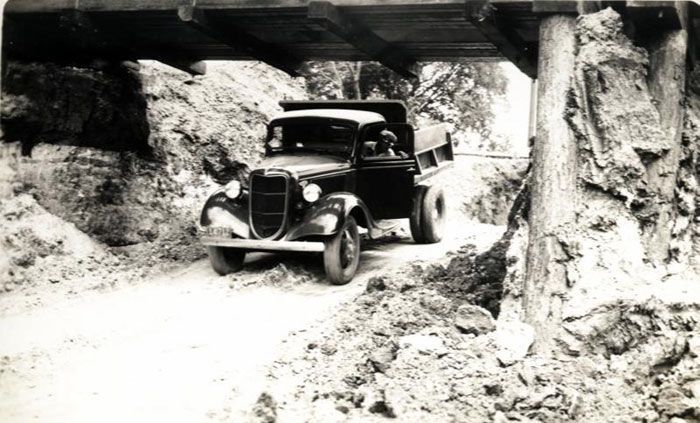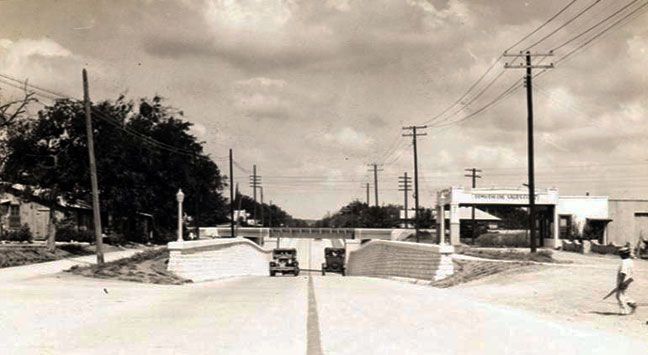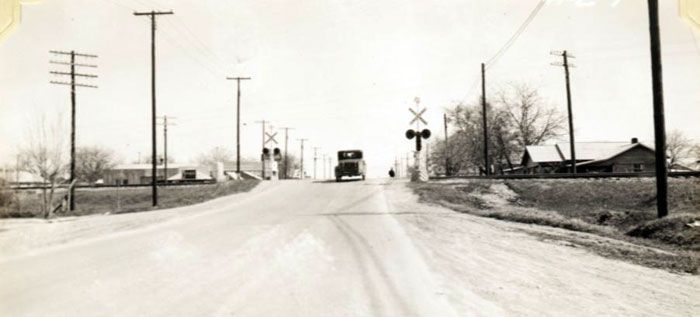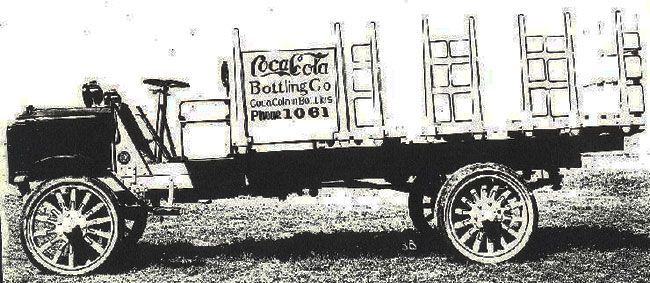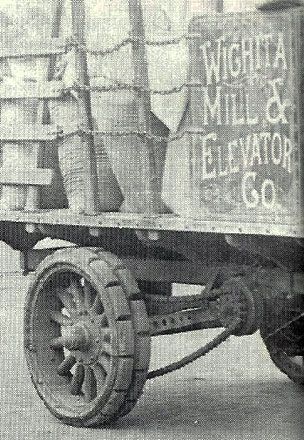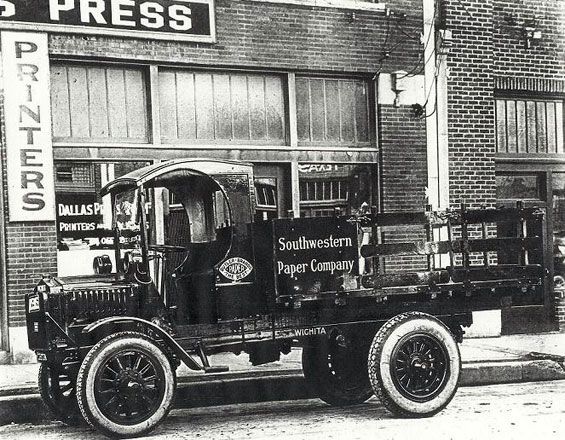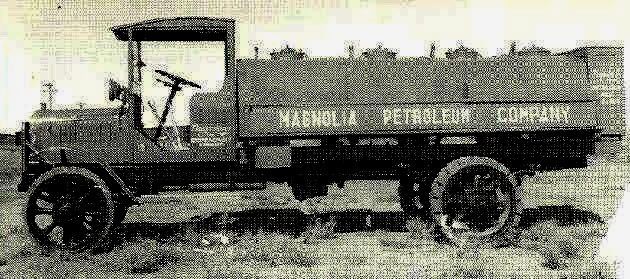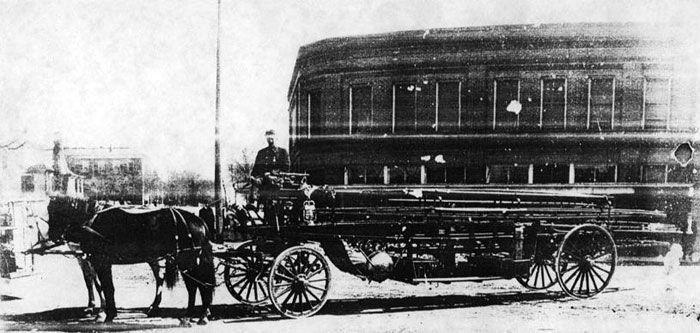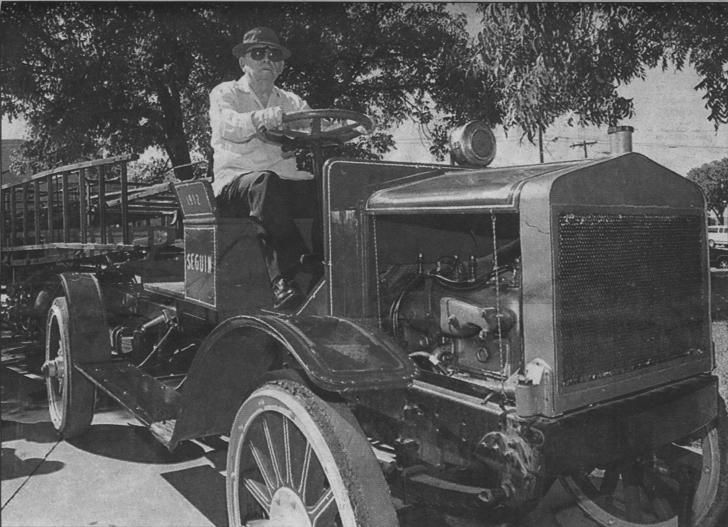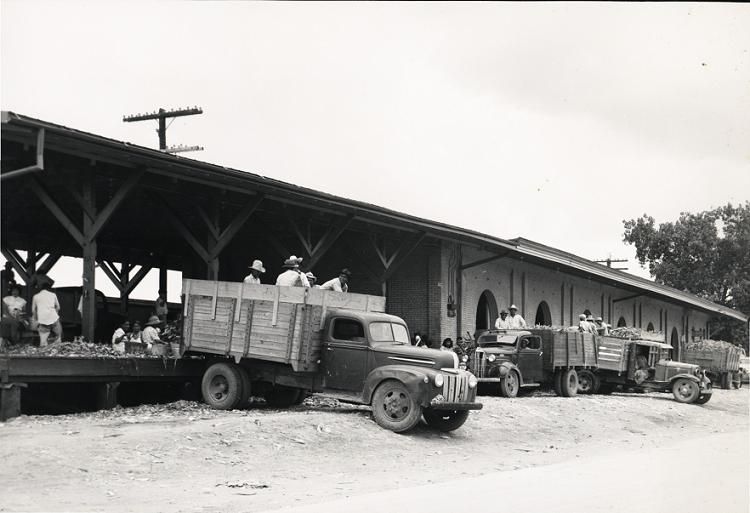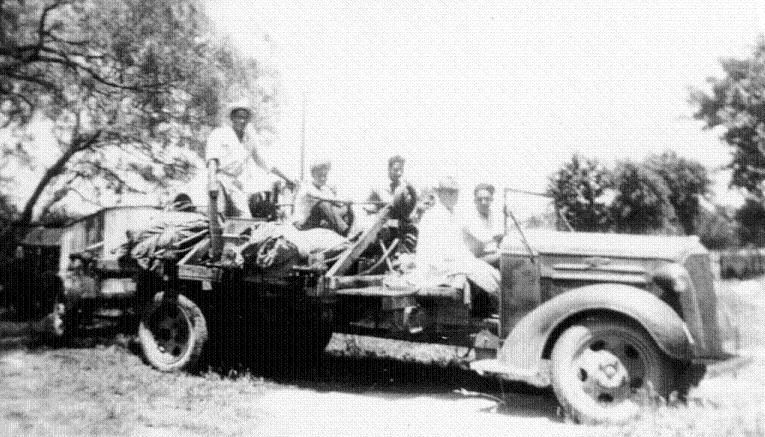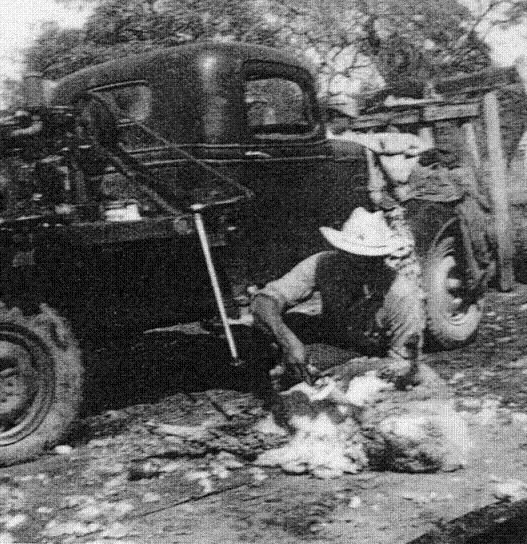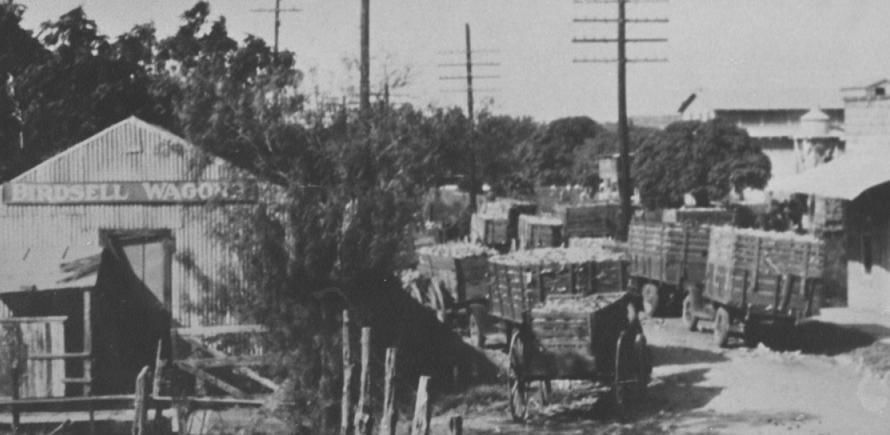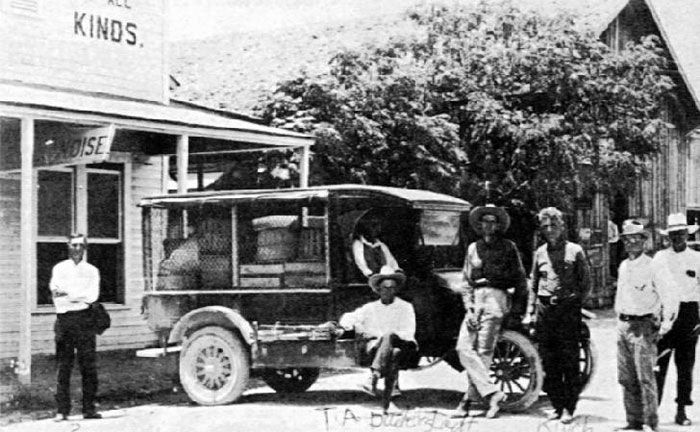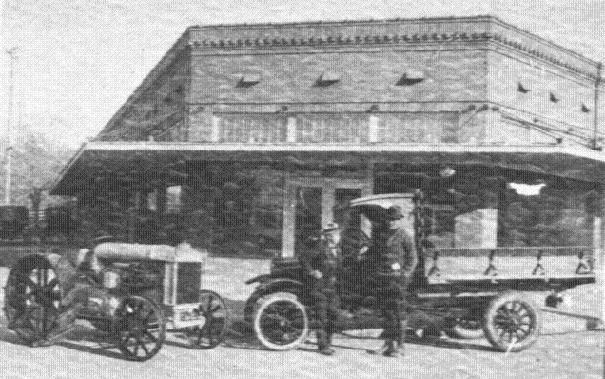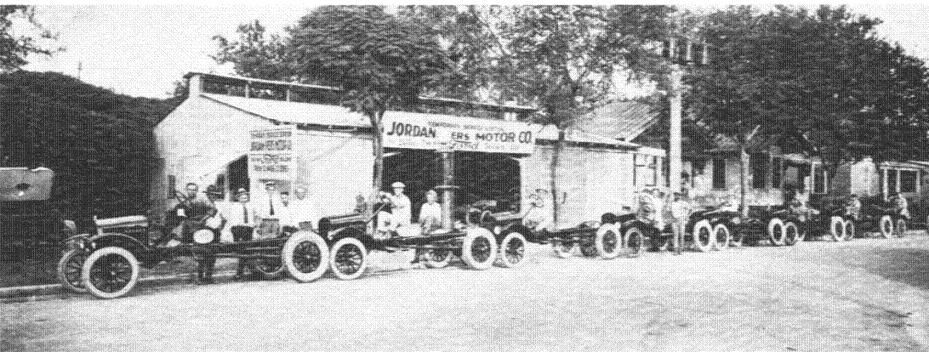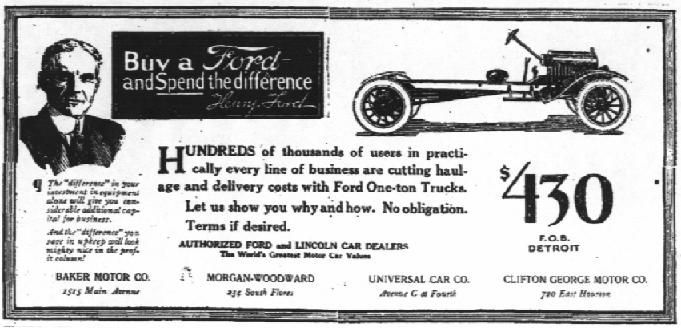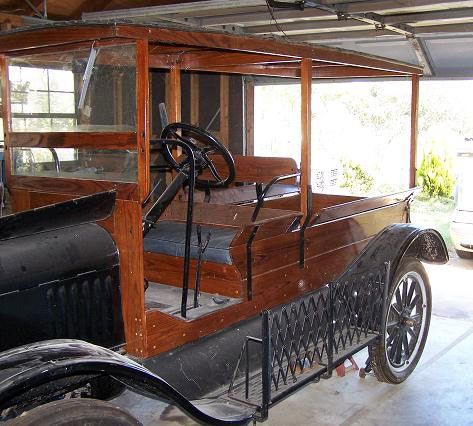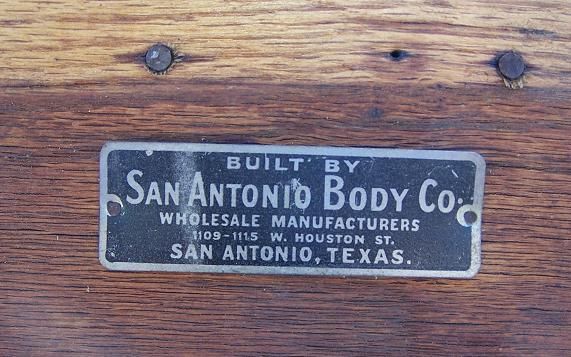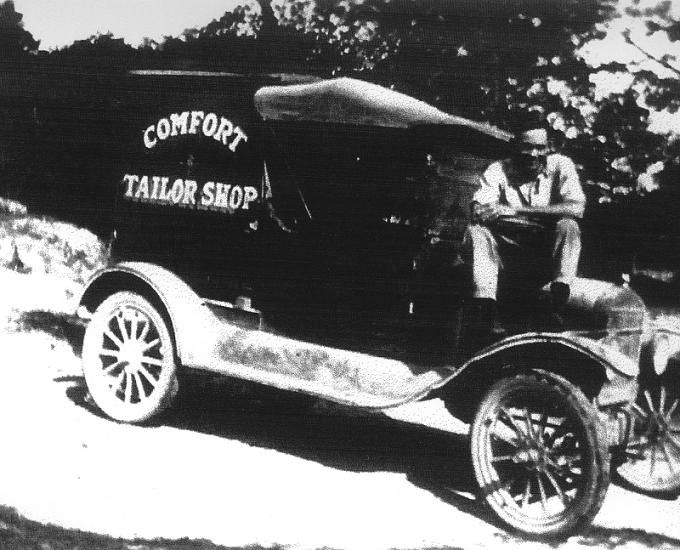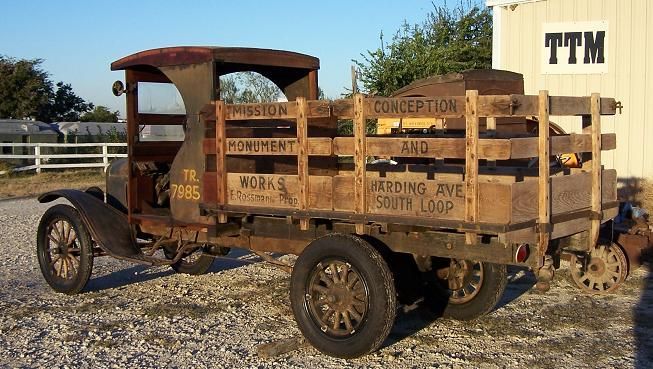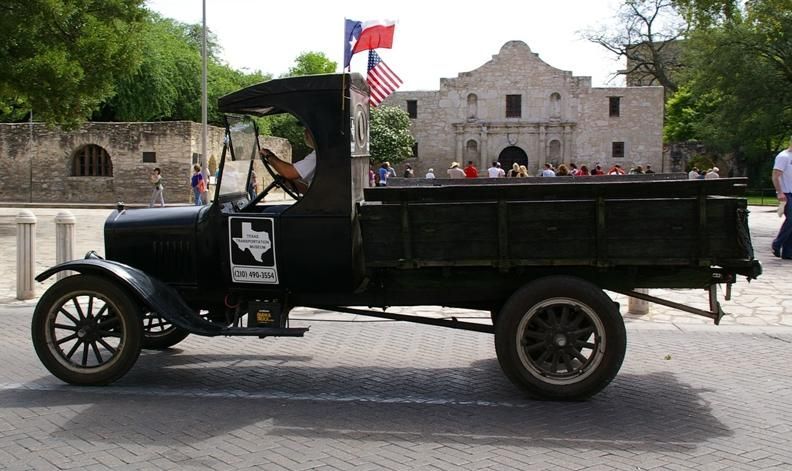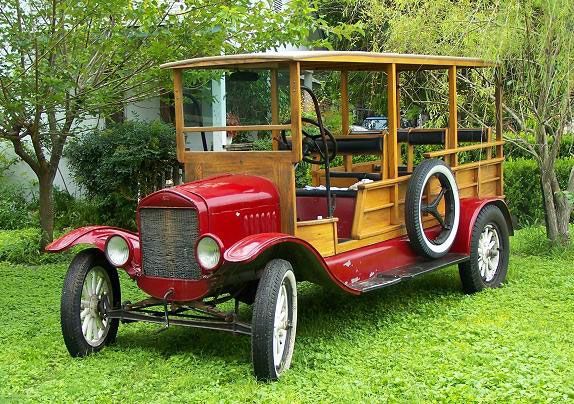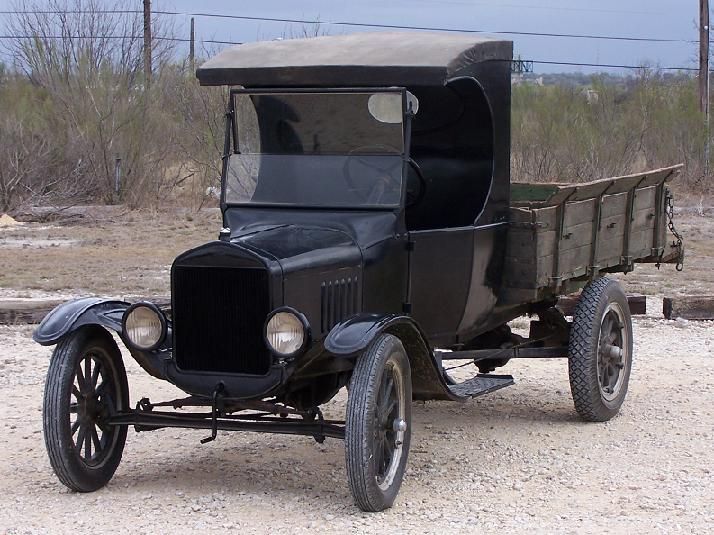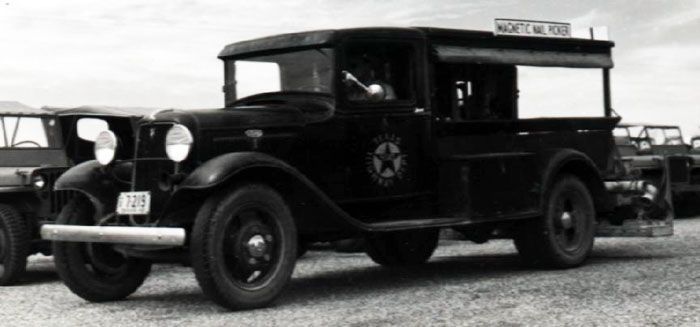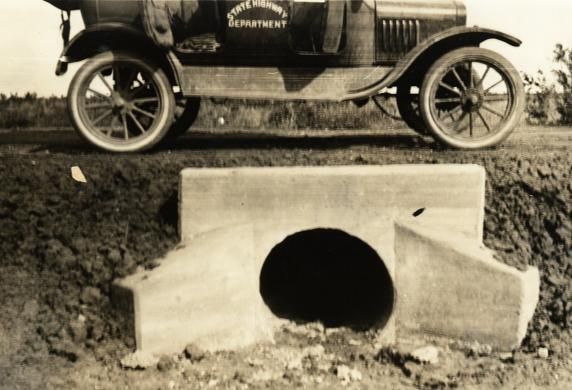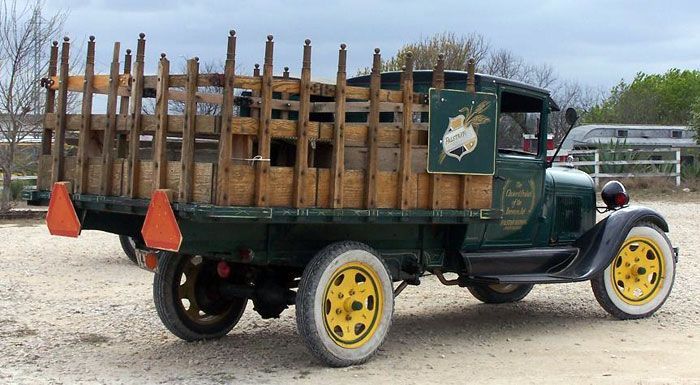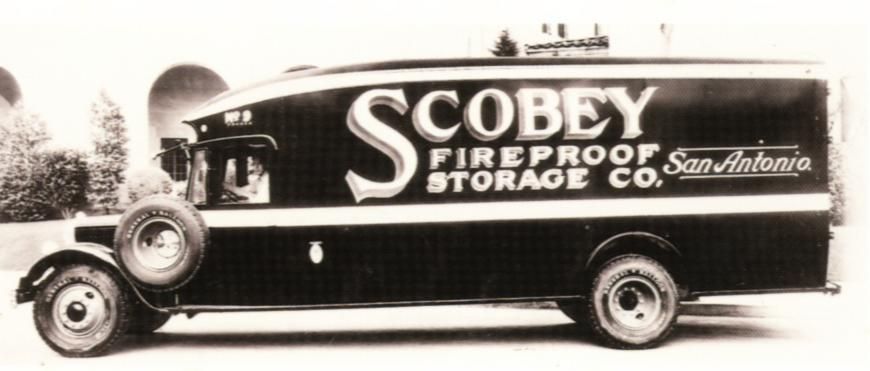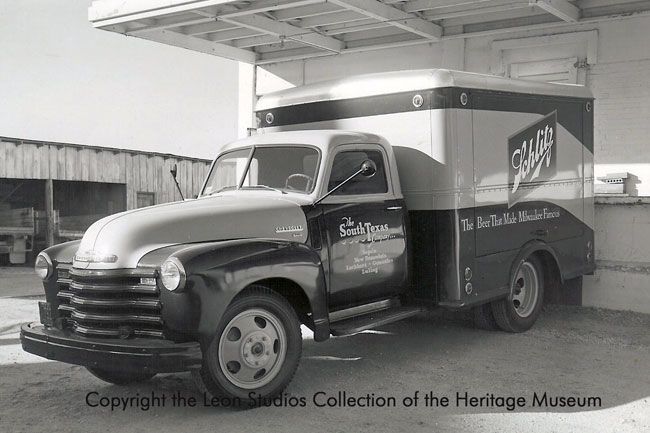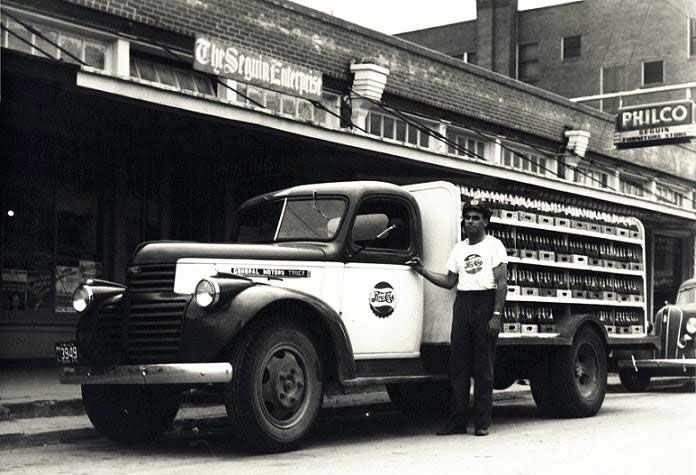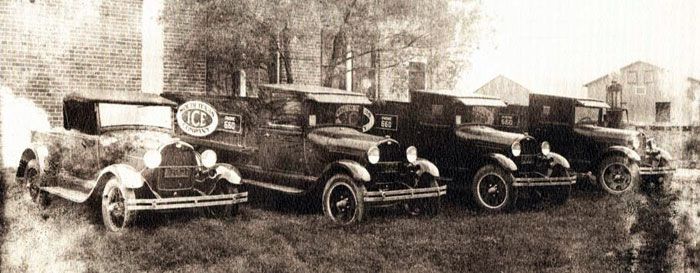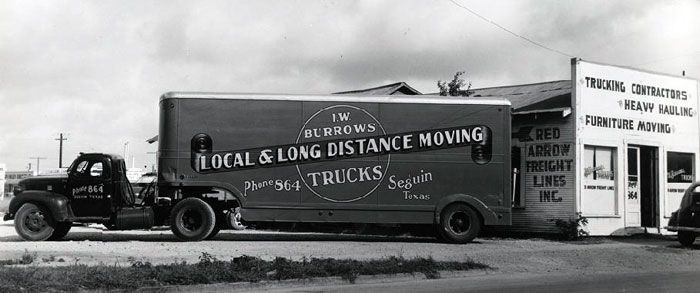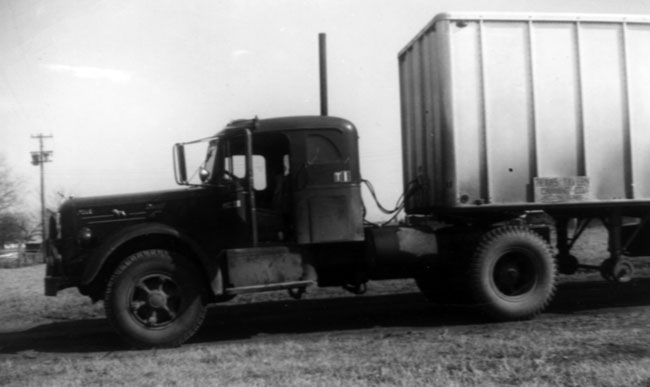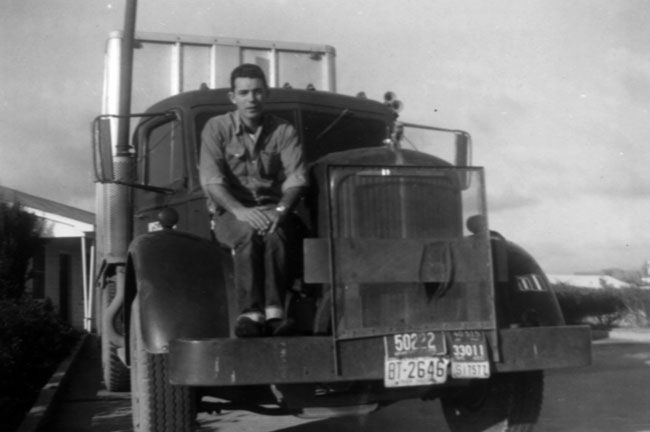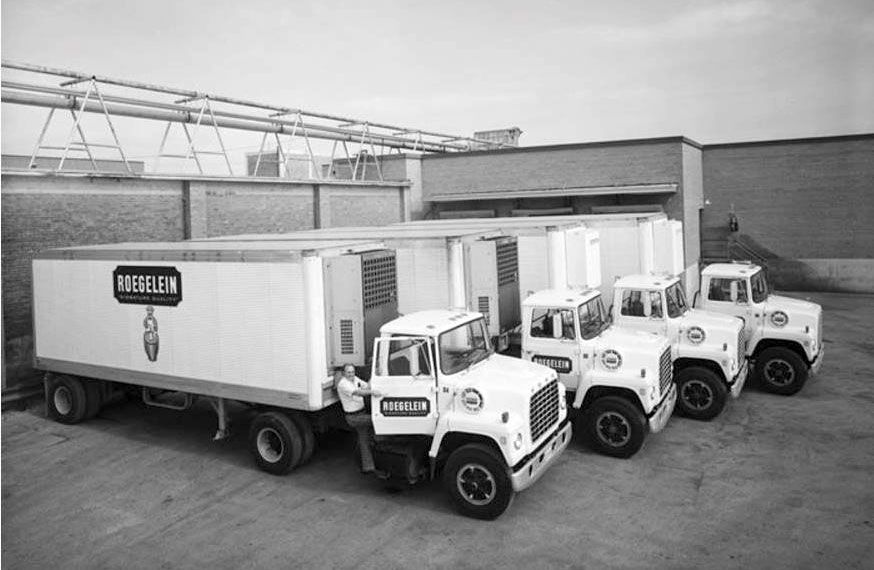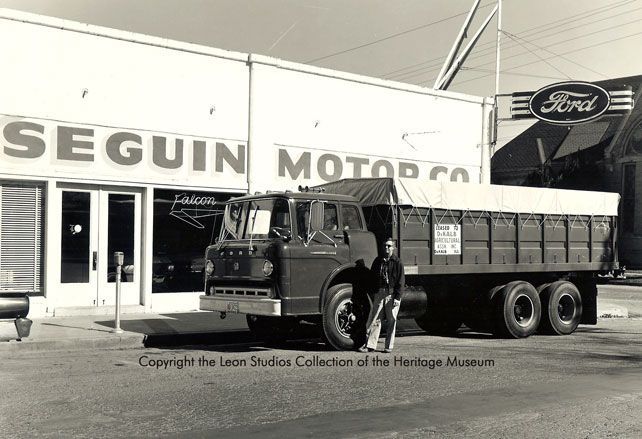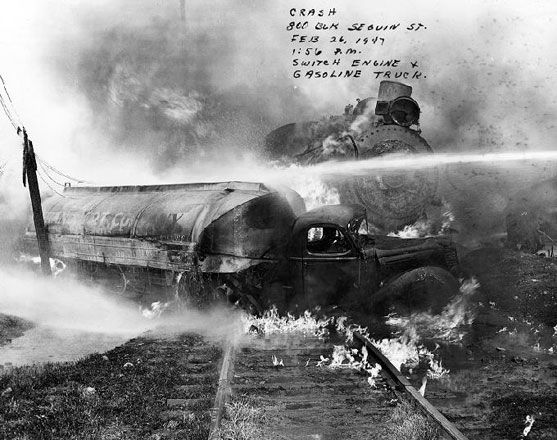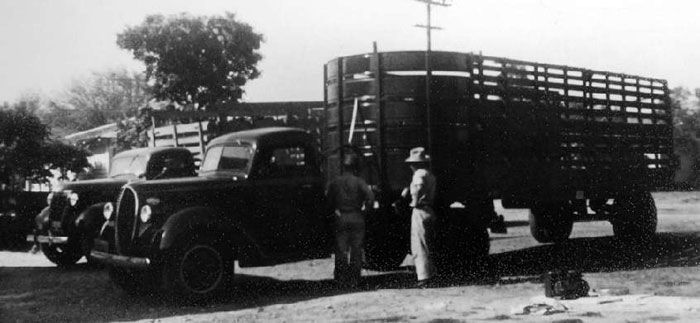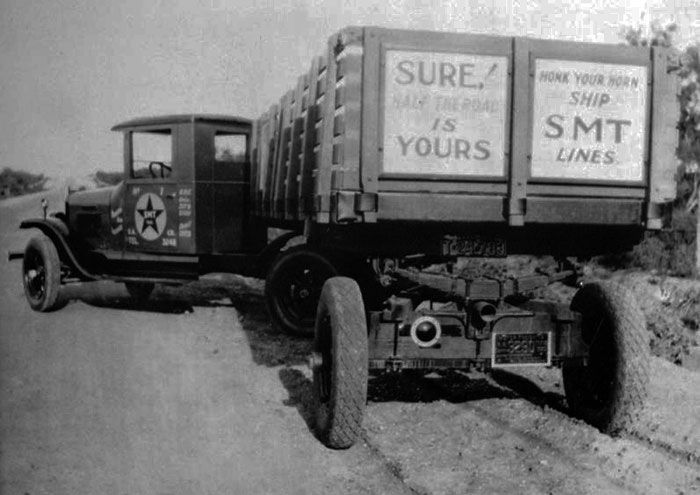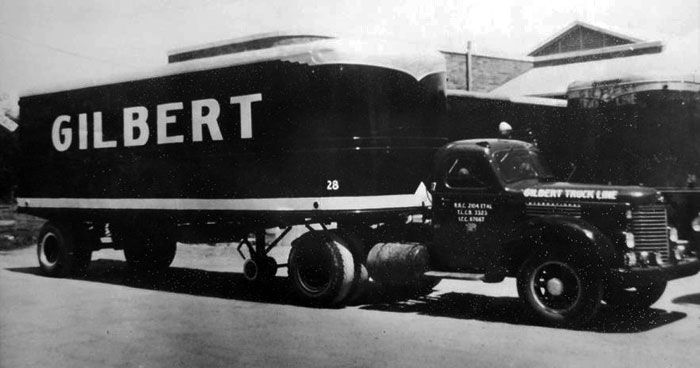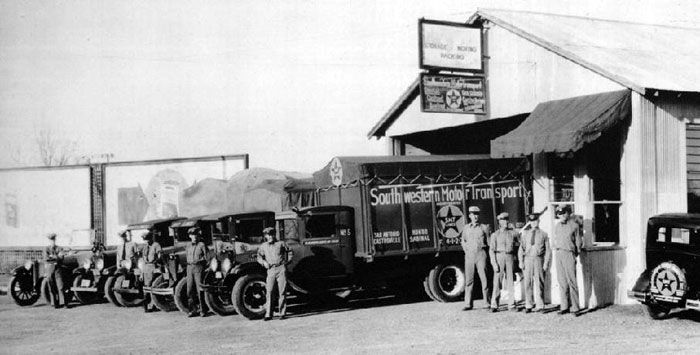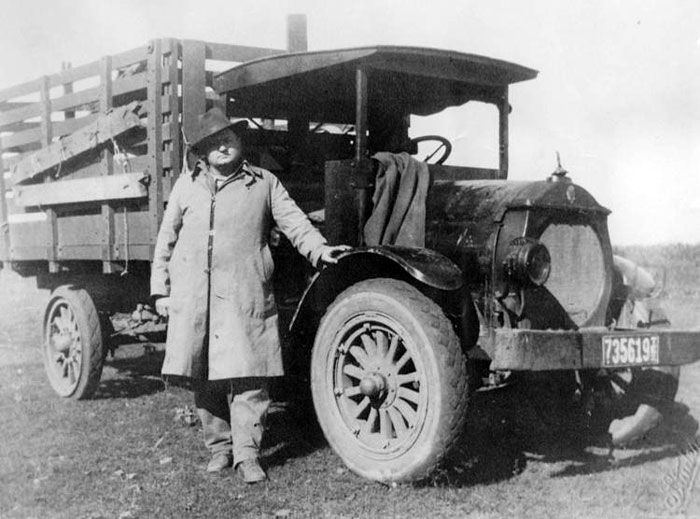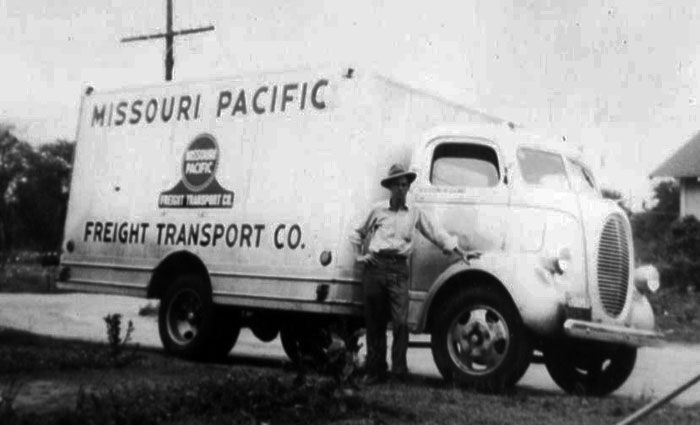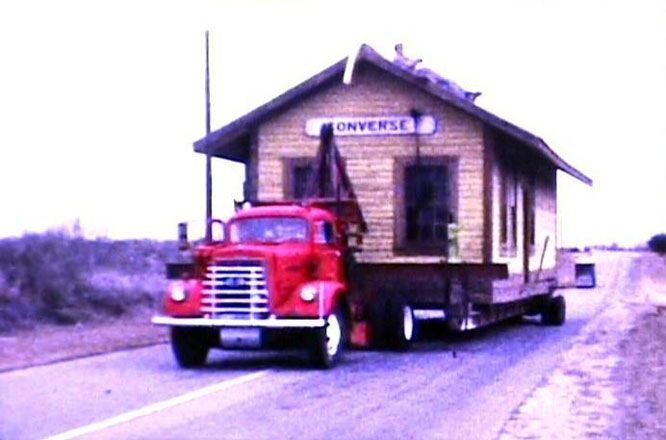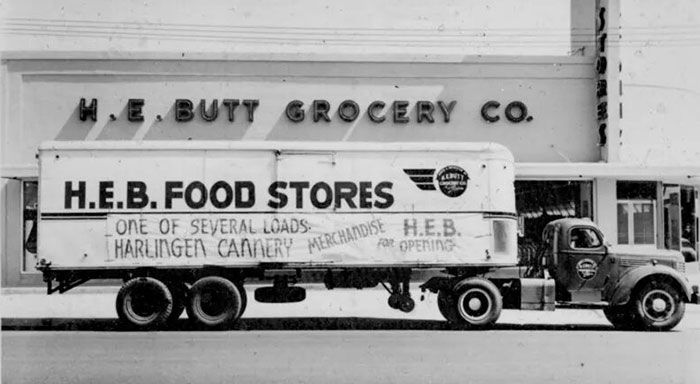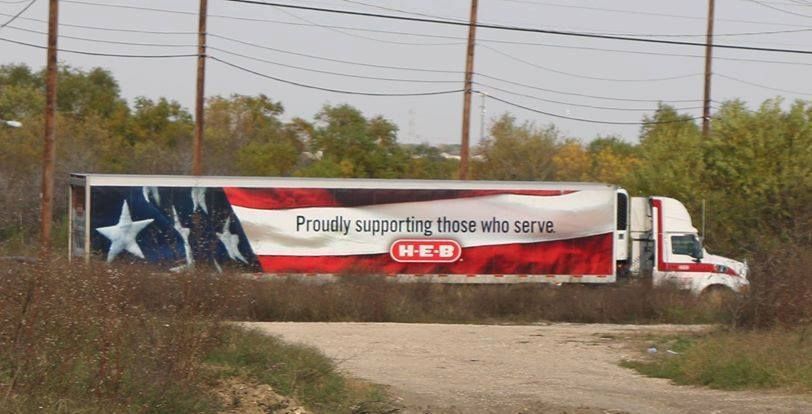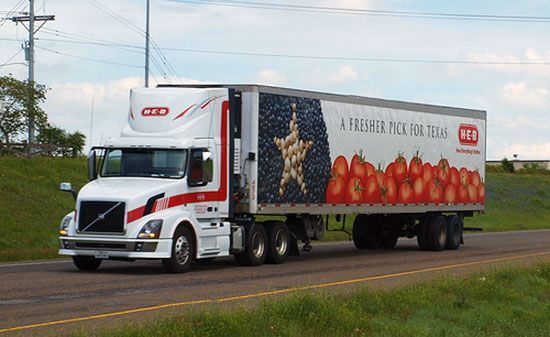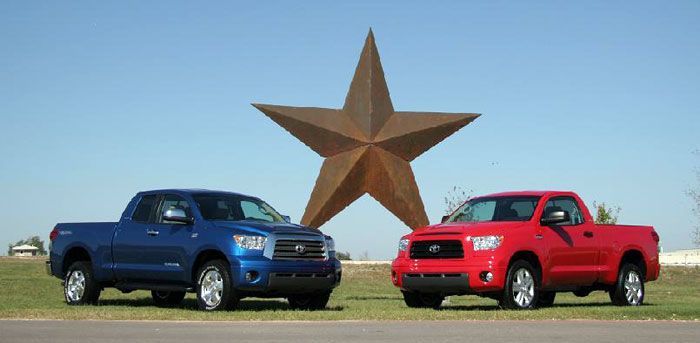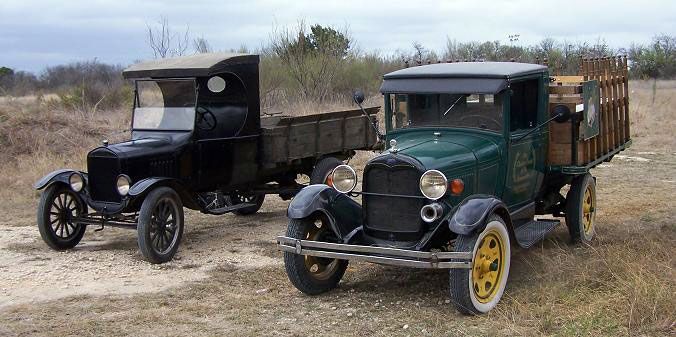The Trucking Industry in San Antonio and South Central Texas
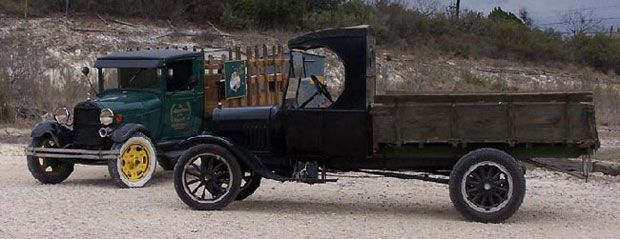
The trucking industry got off to much slower start in South Texas, as elsewhere, than automobiles simply because neither the roads nor the technology needed to move heavy loads safely and efficiently were developed as quickly. The introduction in 1919 of heavy duty low pressure balloon tires by both Goodyear and Dunlop, and solid steel wheels, were tremendous boosts for the industry. Heavy duty trucks in the south were given wider 60 inch wheel tracks instead of the regular 56 inches in the rest of the country. This continued until almost 1930. Trucks, both light and heavy duty, play a vital role in our lives. Everything we use has spent some time, at some point in its product cycle, on the back of a truck. Although it may seem that heavy duty trucks are ubiquitous, in the year 2000 there were more motorcycles registered in Texas, 187,000, than trucks, only 155,000. This compares with 7.6 million cars and 5.8 million light trucks, which include a huge number of personal use pick-ups and sport utility vehicles.
Early Trucks and bad roads in South Texas
The earliest motorized trucks were crude affairs, most often fitted with solid tires. Until tire technology caught up with the ever increasing vehicle weights and speeds, car and truck drivers were obliged to fix tires all too frequently, far more often than they filled up with gasoline. With schedules to keep, trucks had to use solid tires, at least in the rear. The drivers had to put up with a lot of discomfort, steering their heavily laden, unwieldy vehicles over unpaved roads both in town and on the highways. Finding men willing to put up with the discomfort was a huge problem. The beer industry was the largest early user of heavy duty trucks as early as 1917.
The conditions of roads until the 1920s were also a major problem. Largely unpaved, they restricted the use of trucks for the haulage of freight to urban areas or to and from railroad depots. Trucks were instrumental in building better roads, often hauling material directly from railroad cars. Most early roads between towns followed the railroads which already had established rights of way and were built along the flattest terrain in the area. Early drivers often laid out their routes. There were no road signs so following the tracks was the best way to avoid getting lost.
Witchita Trucks
One of the best selling early very heavy duty vehicles in America had strong ties to San Antonio. Established in 1911, the Wichita Falls Motor Company was the most successful vehicle manufacturers of the thirty or so Texan independents. They designed and built tough, dependable vehicles for any number of purposes, such as off road logging, oil tankers, buses, specialized road construction vehicles and fire trucks. Their rugged construction also made them popular with the military.
In 1912 a Colorado company ordered 150 Wichita trucks, the largest truck order ever placed up to that time in the entire country. At the same time, San Antonio businessman Frank Winerick, who owned the Woodward Carriage Company, needed to find a new business, as the writing was on the wall for horse drawn vehicles. In May 1912 he became the largest investor in the Wichita Falls Car Company and a company director. He tried hard to relocate the company to San Antonio, even taking a delegation from the Chamber of Commerce, but production stayed in Wichita Falls.
America was by 1914 the largest industrial nation in the world with 36% of all output, more than Great Britain, France, Germany and Russia, the main combatants in the Great War, combined. Wichita trucks were in great demand. 3,600 were delivered to the French army and another 400 to the Russians. Following the war, Wichita’s export drive accelerated. It adopted the slogan, “The sun never sets on a Wichita.” The company’s products could be found in eighty-six different countries. As a special order, it rapidly replaced the wooden wheels of one vehicle being used to transport the harem of an African potentate with custom made steel wheels because the originals had been consumed by ants overnight.
The company failed in 1932 during the depths of the Great Depression, due to declining sales and encroachment from vast organizations such as General Motors, which moved into industrial vehicles as the demand for automobiles fell sharply. Some folks blame weight restrictions introduced in Texas in 1931, as the Wichita were primarily in the very heavy truck business. If they had held on just a little longer, the Federal Government could have come to the rescue. Under the New Deal, over one hundred thousand trucks were acquired to facilitate the many construction projects across the nation.
Of the more than ten thousand Wichita trucks built, including several buses acquired by the San Antonio Uvalde & Gulf Railroad, only three or four examples remain. One is an articulated tractor purchased by the Seguin fire department to pull a ladder wagon, replacing a team of horses. Having been all but abandoned, the entire ensemble was acquired by a Wichita Falls resident and restored. It now takes pride of place in parades in the north Texas city.
Trucks and Farmers & Ranchers in South Texas
By 1920, 25% of all trucks in Texas were owned by farmers who used them to bring their produce to market plus bring back supplies of all kinds. Almost 50% of all trucks were based on the Ford Model T, which could be purchased as a chassis and engine combination and then adapted by local companies for any number of purposes. In 1917, Ford introduced the TT, or T Truck, the only significantly different version of the Model T produced by the company during its nineteen year production run. It had a lengthened and strengthened chassis and a lower ratio rear end to enable the standard 20 horse power, four cylinder engine to move heavy loads. This came at the sacrifice of speed, which was reduced to a maximum of only 18 MPH.
The huge variety of Model TT truck cabs and bodies reflect the vast number of companies involved in constructing them. In 1924 Mr. E. Rossman, the owner of Mission Monument Works, located on South Loop at Harding Avenue, a grave stone supplier, purchased a Ford Model TT from the San Antonio Body Company, located at 1109 W. Houston. This vehicle remained in service for decades. Like many Model Ts it almost became part of the family and was kept going long after its so called replacements had come and gone. It has survived complete with original faded paint. It is now owned by Daniel Bratcher, the president of the San Antonio Model T club, the “T Fords of Texas.”
The post office used TTs for delivering mail. Others were built as depot hacks by local hotels to ferry their customers and their luggage to their establishments from railroad stations. In 1924, as sales of regular Model Ts began to slide, Ford began producing the iconic C cab TT as a way to increase revenues from truck sales. One of these, with a simple wooden bed, can be found at the Texas Transportation Museum. It was donated by the Rice family from Marfa, Texas, following decades of hard ranch work. Over the years its engine was substantially “upgraded” with the substitution of a Ford Model A carburetor, a 1950s generator and even a water pump, indicating that the vehicle, which has a home made tow bar as well, was used for serious work in West Texas. Most of these additions eventually failed and the vehicle has been returned to its original configuration.
There were, of course, plenty of heavy duty trucks built by other manufacturers in our area. One of the first car dealers in San Antonio, the Citizens Auto Company, located at 222 Travis, purchased a 1921 REO Speedwagon. It is not known exactly how it was originally configured but when what was left of the vehicle was acquired by Ralph Wilhelms of Castroville in the 1970s, he found evidence that its last function was as a depot hack. Maybe Citizens used it as a courtesy vehicle. Ralph, a master carpenter, rebuilt it to continue to fulfill this function and the vehicle has been entered into any number of events, including the 2007 King William parade.
Trucking Industry Regulations introduced in Texas in 1931
Responding to a cacophony of complaints about poor service, lack of insurance and even outright theft of cargo by unscrupulous operators, the state begun to regulate the trucking industry in the early 1920s. In 1927 the Motor Transport Division was created within the Texas Railroad Commission. The oil industry regulation department was created within the TRC as well because it was the state’s only developed agency. In 1928 the Texas Bus Owners Association and the Texas Truck Owners Association were formed to influence state regulations. For several years both organizations had the same leader, Joe Carrington, until the needs of both industries diverged.
San Antonio Transportation Association formed in 1921
San Antonio was in the forefront of these developments. The San Antonio Transportation Association was formed in 1921. It is the second oldest transportation trade group in the country, second only to New York. Still going today, it provides an opportunity for transportation professionals in the trucking, railroad, bus and air industries plus the military, to get together and discuss common issues involved in keeping Texas freight moving.
While the 1927 bus regulations had been largely welcomed by bus companies, the 1931 trucking regulations caused an outcry that still reverberates today. There was little complaint about the need for all trucking companies to be licensed, bonded and insured. The major point of contention was that Texas imposed the toughest weight limits in the nation. Trucks serving more than one railroad depot could not carry more than 7,000 pounds. The state’s position was logical if unpopular. The road network was primitive at best, with substandard roads and bridges. Road engineers had to come up with the most cost effective way to establish a good road system for the majority of road users. Of the 206,000 trucks registered within the state in 1931, only 5,500, less than one half of one per cent, were rated to carry over 7,000 lbs. Building thousands of bridges to accommodate such a tiny fraction of road users was not practical. Such vehicles, many still fitted with solid tires, also caused a disproportionate amount of damage, especially to the still small number of very expensively paved roads.
The regulations were challenged all the way to the US Supreme Court. While the state won its case, there was a great deal of bitterness towards the Railroad Commission, which was accused of being in the pocket of the railroad industry, ignoring the fact that the TRC had been formed to control the railroads when they had an absolute monopoly in Texas.
Opposition to Trucking Regulations in Texas
The number of state weight inspectors rose from just eighteen in 1927 to fifty in 1929 and one hundred twenty in 1931. There were numerous confrontations between truckers hauling winter fruits and vegetables from the fertile South Texas Valley which was served by just one road. Following a blockade busting run of fifty trucks one year, state troopers amassed in great force. They stopped every truck, most of which were over loaded. Stuck on the side of the road, without refrigeration, the sensitive crops were ruined. The weight restrictions would not be lifted until after the Second World War.
There were many more restrictions. There were rules regarding which cities each company could serve, how much they could charge and which roads their trucks could use. A specific license had to be acquired for each route. Deviating from the approved road to take a short cut would mean a hefty fine. The state paid people to report any violations, as did insurance companies. Trucks were obliged to carry large identifying numbers on the side to make the task easier. Trucking companies were treated as if they were railroads, with fixed routes and state oversight of all rates and fees. Before a trucking company could raise its prices it had to apply to the state for permission. The tide of bureaucratic red tape would not recede until the presidency of Jimmy Carter
Small Town Trucking Companies in South Texas
The freight haulage trade was initially dominated by small companies, often one person, one vehicle operations. Most small towns had at least one trucking business. In Marion, between Seguin and San Antonio, it was Lynn Hensley. His operation consisted of two medium duty Chevrolet bobtails, a truck with a longer bed supported by two rear wheels on a single axle. Mr. Hensley provided free rides to students attending schools in San Antonio such as Jay Huebinger, who attended Central Catholic in the early 1940s.
SMT Truck Lines
In Cotulla, half way between San Antonio and Laredo, it was Roy Gilbert. His father, John, a dairy farmer, had built his own rough looking truck from old parts in the early 1920s. Trucks did not last long in those days and it was not uncommon for people to combine good parts from worn out vehicles to construct a replacement. John used the truck to haul his own produce to San Antonio. Friends and neighbors would ask him to take things to and from the city and he found he was making just as much money hauling goods as he was farming. His son, Roy, decided to get into the business full time. In 1930 he acquired a second hand truck, a serous commitment in the Great Depression, and formed Gilbert Truck Lines.
Gilbert Truck Lines secured a license to serve San Antonio from Cotulla. During the early depression a twenty year old by the name of Lyndon Baines Johnson, whose father was a Texas state bus inspector, came to the town to teach at the segregated school for Hispanics. Yet to achieve his university degree, he could not afford a car. He often took a lift into San Antonio in the cab of Roy’s truck. A lifetime friendship between the two young men, both of whom shared a driving ambition, was formed, one that would see both leave Cotulla far behind.
By 1939 Gilbert Truck Lines had 40 employees and a small fleet of trucks. The development of better tires and multiple wheeled axles made the job of moving freight along Highway 83 a lot more comfortable. In 1940 the company acquired a license to serve Laredo. This provided a significant income boost and their headquarters were moved to the border city. In Uvalde, a slightly larger company called Southwestern Motor Transport Lines had been created in 1930 with a license to run between San Antonio and Del Rio. In 1950 Mr. Gilbert bought the operation and put the name on his own trucking company.
It was around this time that Southwestern Motor Transport, like many others in Texas, became embroiled in a serious conflict with the truck drivers union. By this time LBJ had risen to the position of leader of the US Senate. When hearings were held to find a solution to the problems plaguing the trucking industry both he and Mr. Gilbert, old friends from their days in Cotulla, found themselves sharing space in the grand surroundings of the Capitol Building in Washington D.C. Their paths would cross again regarding the financing of the proposed interstate highway system. The initial plan proposed by the Eisenhower administration, seeking to avoid deepening the national debt when paying for the new roads, involved soaking the trucking industry via a hefty tax on heavy duty tires. LBJ never forgot a friend and simply blocked the proposal, almost without discussion.
Railroad Company Truck Lines
It may come as a surprise but the railroads were very heavy users of trucks. In fact for about thirty years after World War Two the largest trucking company in the USA was owned and operated by the Southern Pacific Railroad. The company introduced many innovations such as piggy backing trailers over the rails to cut costs, long before the introduction of the now ubiquitous forty foot container designed to be easily moved from ship to truck or train. For cost reasons it was also easier to ship LCL – less than car load – freight by truck than by railroad. And long before UPS or FedEx, there was the Railway Express Agency, whose distinctive green vans roamed the nation for almost sixty years, delivering parcels and picking up luggage on behalf of travelers, back when they might be obliged to spend days on end on a train to get to their destination.
HEB Truck Services - the best in the industry
The HEB grocery chain, based in San Antonio, is one of the best run regional grocery chain in the nation. Its sophisticated inventory control systems are capable of controlling costs to the fraction of a penny. This allowed it to beat out less well run national companies like Kroger and Albertsons. One of the keys to the company’s formidable reputation is its vast trucking operation which enjoys an enviable reputation within the industry. Roy Gilbert of SMT Truck Lines, no slouch himself at running a vast fleet of vehicles, has nothing but the highest praise for HEB’s trucking operations. HEB pays its drivers top dollar but its expectations are extremely high. You rarely if ever hear of bad HEB truck drivers. As a result HEB stores receive deliveries right on time. This efficiency is a significant reason why HEB is able to maintain a price advantage over other retailers.
Maintaining San Antonio’s history of forward thinking, Bexar County Judge Nelson Wolff and banker Tom Frost helped to create the Free Trade Alliance in 1994, around the same time that that NAFTA, the North American Free Trade Agreement, went into effect. The FTA seeks to promote cross border trade, fully aware that San Antonio is in pole position to benefit from increased trade between the USA and Mexico. While it true that more Mexican companies have signed up for the pilot program of one hundred trucking companies on each side on the border allowed to haul freight into the other country, the US firms have actually made more trips. The program expressly forbids the pick and delivery of freight within the other nation, but the trucks may pick up freight intended for delivery back to their own side. With the problem of far too few over the road drivers in the USA, a situation that stretches back to the beginning of the industry, the arrangement does offer one solution, even though it has to be said that NAFTA as a whole is far from popular with many people on both sides of the border.
Transportation Museum
CONTACT US TODAY
Phone:
210-490-3554 (Only on Weekends)
Email:
info@txtm.org
Physical Address
11731 Wetmore Rd.
San Antonio TX 78247
Please Contact Us for Our Mailing Address
All Rights Reserved | Texas Transportation Museum
